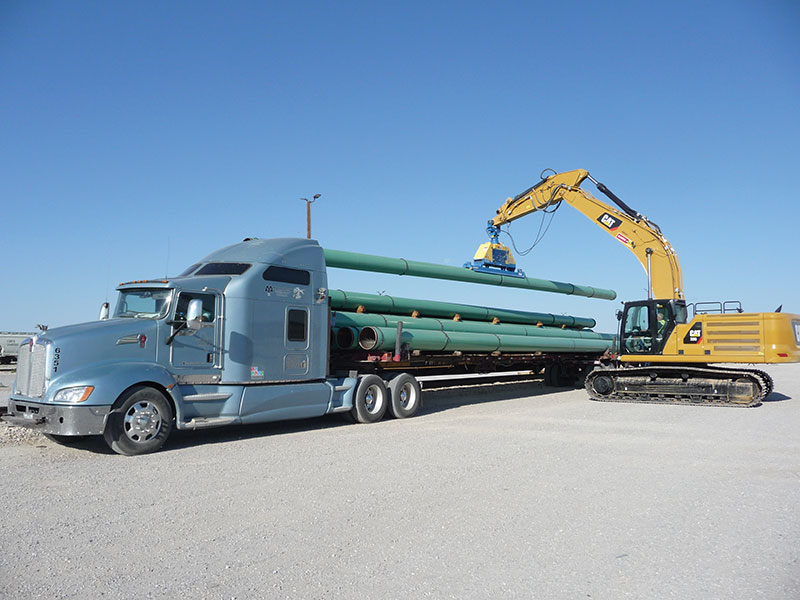November 2020, Vol. 247, No. 11
Features
Handling Pipe Remains Long-Standing Business for Montgomery Family
Special to P&GJ
Amere 75 years ago, Lewie Montgomery decided to go into the pipeline stringing business for himself. Prior to that he was working on the War Emergency Pipelines for Dun Brothers.
Ernest Dun asked Montgomery to go to West Texas and open a trucking terminal to take care of all the new pipeline business that El Paso Natural Gas was beginning to construct in Southeast New Mexico and West Texas. Montgomery decided to go into business for himself rather than start up an operation for the Duns.
From that beginning in 1945, he, along with his son, grandson and now great grandson have continued in the pipeline stringing business. It all started in Odessa, and offices of what would become MTI Logistics were opened in Houston in 1981.
The pipeline stringing business quickly expanded to the unloading and stockpiling business, which includes the yard location, yard preparation, and handling and storage of the large quantities of line pipe for construction projects. These are still the core of the family business.
There are now three companies that manage the combined business: MTI Logistics, MTI Transportation Services and Montgomery Trucking Co. The companies perform services for oil and gas pipeline companies, pipe manufacturing companies, pipeline contractors, engineering and construction management companies and pipe supply businesses across the USA.
The companies now headquarter in Houston at its 11-acre yard and have temporary construction offices wherever they are performing the services for their clients.
When the pipeline is in its concept and planning stage, the company consults with the pipeline company and the steel pipe manufacturer to determine the best location to store the pipe prior to beginning actual construction. When those locations are determined, the staff at MTI Logistics researches and locates acreage that will be acceptable for the storage of the miles of line pipe that soon will be arriving.
There are considerations like adequate drainage, to avoid creating muddy conditions; acceptable ground conditions, for construction of roads and pipe racks; and adequate roads entering and leaving the proposed storage yard, to allow for legal and safe transportation of the long oversized loads that will be entering and exiting from the storage yard.
When the pipe starts arriving by rail or truck, the Montgomery crews unload the pipe into the storage yard on the prepared rack, usually made up of earth berms covered with geotech. The pipe will remain in the storage yard until the pipeline contractor is ready to receive the pipe on the right-of-way.
The motto of the Montgomery businesses has always been “Safety First – Service Always.” From the planning to the execution of the transportation, the safety of the general public and the construction crews is always the number one thought on everyone’s mind.
Montgomery trucks are all equipped with the latest technology, from keeping the driver logs electronically to tracking the movement of the vehicles with cameras. Every Montgomery project has a safety supervisor to ensure that project personnel follow company and client safety guidelines with positive attitudes.
Montgomery safety supervisors also make sure the handling equipment and transportation vehicles are in safe and reliable condition to perform the required tasks. There is contact between the drivers and the office on every load handled so records can be kept accurately on the movement and location of every joint of pipe being handled.
The specialized equipment that Montgomery uses includes the extendable and steerable pole trailers that transport the line pipe, which ranges from 80 to 85 feet (24 to 26 meters) in length. The trailers use steel cables so the trailer track will almost be in the same tracks as the truck.
That makes it possible to transport the long loads of pipe around tight corners on the way from the pipe mill, rail car unloading site, storage yard and onto the right-of-way for stringing.
Jimmy Montgomery often gives a speech about the hazardous nature of transporting the long loads of pipe. He begins by telling the audience that trucking is hazardous because you must use a large truck and trailer combination and do that along the highways with cars that want to cut in on the truck and slam on the brakes in front of the truck.
The stopping distance that it takes to stop a tractor trailer rig with a combined vehicle weight of 80,000 pounds (36,287 kg) is much more than the cars on the road. Then, add pipe, which is round and wants to roll, and it becomes more hazardous. Because the pipe is 80-feet long on a steerable pole trailer that does not take corners like all the other trucks out on the highway and it becomes even more hazardous.
The total combined length from the front of the truck to the back of the pipe is usually about 100 feet (30 meters). This usually has the audience wondering, how can this be done without doing great harm to the general public? Montgomery explains that, yes, it becomes very hazardous, but it can be done safely if the truck driver does all those little things along the entire process in a safe and planned manner, just like we teach every day.
If you leave even one little detail of the planning, preparation and execution of the transportation service out, it can become unsafe and hazardous. Montgomery’s well-trained drivers and crews perform these details every day and safely transport the line pipe several hundred times per day.
When handling the pipe, Montgomery normally uses excavators with vacuum lifts to pick up and move the individual joints of long pipe. Occasionally, Deck Hands, a clamp-type attachment, has been used to pick up the pipe.
Either method is far superior in safety and efficiency to the cranes and side booms with cables that were used for many of the 75 years that the pipeline stringing services were performed.






Comments